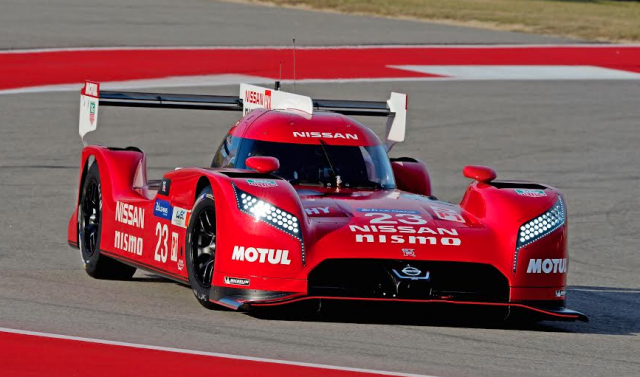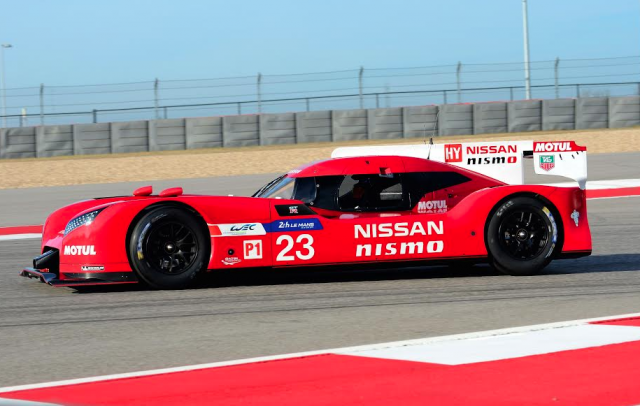

Nissan’s front-engined GT-R LM Nismo is undoubtedly the most ambitious prototype yet conceived under the ACO’s current hybrid regulations.
The car’s designer, Ben Bowlby, has targeted an 8MJ hybrid system; the maximum allowed under the rules that trade-off electric and internal combustion power.
By comparison, Audi won last year’s Le Mans 24 Hours with a 2MJ system, with Toyota and new-for-2014 players Porsche having opted for 6MJ.
The Nissan’s combination of the 3.0 litre V6 twin turbo and hybrid propulsion is said to produce 1250bhp when operating at full power, with more than half coming from the latter component.
The front-mounted petrol engine powers the front wheels, while the hybrid system harvests energy from the front axle and can be fed back through the front or rear wheels.
The tyres are also wider, 15 inch compared to nine, at the front than the rear as part of Bowlby’s over-all design concept.
In the below Q&A, Bowlby explains how and why Nissan has taken such bold steps ahead of its return to Le Mans for the first time in 16 years.
QUESTION: Can you explain how the different power sources work on the GT-R?
BEN BOWLBY: We have a very modern but conventional V6 3-litre twin turbo petrol engine. This is a very efficient engine so it produces a large amount of power using the allotted fuel flow limit.
The fuel flow limit is one of the new regulations at Le Mans – we’re not limited by the engine capacity or the boost pressure or the RPM of the engine – we’re limited by how many grammes of fuel per second we can burn. So the more efficient you make the engine the more power you have because you are still burning the same amount of fuel whether you are efficient or inefficient so if you can make a very efficient engine you get a lot of power.
We are burning a smaller amount of fuel, around 30 percent less than was used by a petrol engine at Le Mans in 2013, for example. So we have a petrol engine efficiently producing a certain amount of power and then in addition to that we are using a kinetic energy recovery system (ERS). The car is a mass, travelling at velocity and as we slow it down for the upcoming corner we harvest that kinetic energy.
We can then deploy that stored energy to accelerate the car out of the corner and because the energy recovery system can release the stored energy very quickly it makes it very powerful. Energy divided by the speed you release that energy equals power.
Think about a stick of dynamite. That’s actually quite a small amount of energy but it is released in a spilt second so it makes a very big bang. The same amount of energy released over a day would hardly even manage to power a light bulb. So it’s all about how fast you release the energy. We want to release the energy very quickly to get the car back up to speed very quickly because it’s nice to spend lots of time at high speed!
The key is to store the energy and then release it very quickly and that’s what makes our system very competitive, providing us with a good amount of power from the ERS, which we can add to the internal combustion engine’s driving power.

QUESTION: Is the GT-R a front-wheel-drive car?
BOWLBY: The Nissan GT-R LM NISMO is in automotive-speak a front-engined, front-wheel-drive car. The internal combustion engine drives the front wheels and the energy recovery system harvests energy from the front wheels.
We’ve used the relatively low-powered internal combustion engine to drive the front wheels and then we add power from the ERS to augment acceleration.
QUESTION: If the GT-R has all this power, will it be faster than the other manufacturer’s LM P1 cars?
BOWLBY: The LM P1 regulations for manufacturers have four hybrid powertrain options, defined by how much hybrid energy is released from the ERS per lap of Le Mans (the Le Mans track is used as the baseline circuit).
You can go in the 2 megajoule class where you can deploy up to 2MJ of energy during one lap of Le Mans and also use quite a lot of fuel. You can go in the 4MJ class and get a little less fuel, the 6MJ class with less still and then there’s the 8MJ class where you get the least fuel of all but the most recovered energy for deployment and there’s no limit on how powerful the system is, just how much energy is used so you can either have an awful lot of power for a very short time or a small amount of power for a very long time.
The fuel energy you have, which again can be measured in megajoules, gets cut in proportion to the amount of megajoules you get from your ERS. The way it is worked out by the governing body – the FIA and the ACO – is that if you choose to recover more energy and deploy that you actually end up with more total energy, even though your fuel energy has been cut slightly. The more megajoules you have the faster you go. Each megajoule is worth an amount of time per lap so if you are an 8MJ car compared to a 2MJ car you should be faster over the course of a lap.
There are however some very big challenges, one of which is that you have to get the car down to the minimum weight because every 10-12 kilos is about half a second a lap around Le Mans so if you have more weight in the car that slows you down pretty significantly.
The challenge is to package a big, powerful energy recovery system without going over the weight limit and that is very hard to do. We’re going to be really challenged to make our weight target of 880 kilos for 2015 when half of the weight of the car is the powertrain: engine, ERS and the driveline – so that’s a very big challenge.

QUESTION: What about the tyres? The rears look narrower than the front tyres!
BOWLBY: The front tyres on the Nissan GT-R LM NISMO are bigger than the rear tyres – 14 inch wide front vs. 9 inch rear. This is due to the way that mass is distributed in the car. We have moved the weight bias forwards to give us traction for the front-engined, front-wheel drive.
We’ve also moved the aero forwards so we’ve moved the capacity of the tyres forward to match the weight distribution. So the aero centre of pressure, the mass centre of gravity and the tyre capacity are all in harmony and that means we have bigger tyres at the front than the rear.
QUESTION: Why doesn’t the Nissan GT-R LM NISMO look like the other manufacturer’s LM P1 cars?
BOWLBY: The regulations have allowed us the freedom to create a significantly different looking car. Nissan are bold challengers who are prepared to innovate in order to get a high performance outcome so we’ve turned the whole concept of the conventional LM P1 car of 2014 on its head. The result is that our car looks different as the cockpit has been moved significantly rearwards to accommodate the engine at the front of the car.”























Discussion about this post